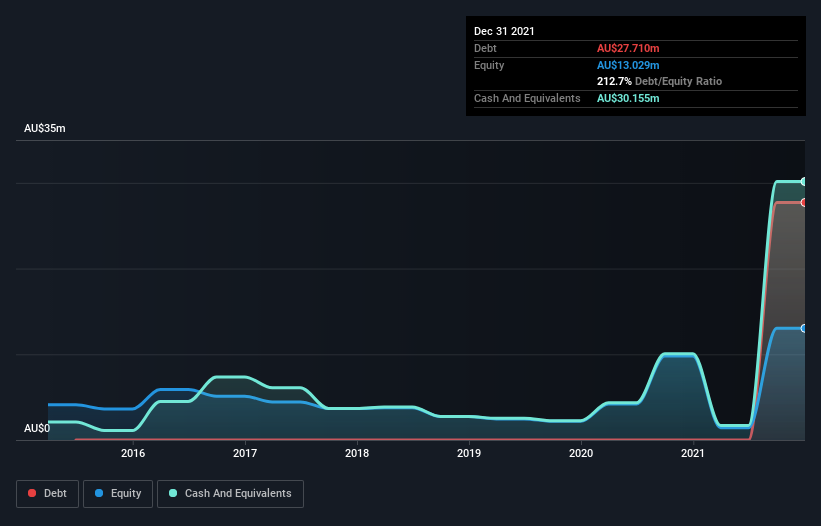Howard Marks put it nicely when he said that, rather than worrying about share price volatility, 'The possibility of permanent loss is the risk I worry about... and every practical investor I know worries about.' It's only natural to consider a company's balance sheet when you examine how risky it is, since debt is often involved when a business collapses. We note that Burgundy Diamond Mines Limited (ASX:BDM) does have debt on its balance sheet. But should shareholders be worried about its use of debt?
When Is Debt Dangerous?
Debt is a tool to help businesses grow, but if a business is incapable of paying off its lenders, then it exists at their mercy. If things get really bad, the lenders can take control of the business. However, a more usual (but still expensive) situation is where a company must dilute shareholders at a cheap share price simply to get debt under control. Of course, the upside of debt is that it often represents cheap capital, especially when it replaces dilution in a company with the ability to reinvest at high rates of return. When we think about a company's use of debt, we first look at cash and debt together.
View our latest analysis for Burgundy Diamond Mines
What Is Burgundy Diamond Mines's Net Debt?
The image below, which you can click on for greater detail, shows that at December 2021 Burgundy Diamond Mines had debt of AU$27.7m, up from none in one year. However, its balance sheet shows it holds AU$30.2m in cash, so it actually has AU$2.44m net cash.

How Healthy Is Burgundy Diamond Mines' Balance Sheet?
According to the last reported balance sheet, Burgundy Diamond Mines had liabilities of AU$593.4k due within 12 months, and liabilities of AU$28.4m due beyond 12 months. Offsetting this, it had AU$30.2m in cash and AU$1.62m in receivables that were due within 12 months. So it can boast AU$2.78m more liquid assets than total liabilities.
This surplus suggests that Burgundy Diamond Mines has a conservative balance sheet, and could probably eliminate its debt without much difficulty. Succinctly put, Burgundy Diamond Mines boasts net cash, so it's fair to say it does not have a heavy debt load! When analysing debt levels, the balance sheet is the obvious place to start. But you can't view debt in total isolation; since Burgundy Diamond Mines will need earnings to service that debt. So when considering debt, it's definitely worth looking at the earnings trend. Click here for an interactive snapshot.
Since Burgundy Diamond Mines has no significant operating revenue, shareholders probably hope it will develop a valuable new mine before too long.
So How Risky Is Burgundy Diamond Mines?
We have no doubt that loss making companies are, in general, riskier than profitable ones. And in the last year Burgundy Diamond Mines had an earnings before interest and tax (EBIT) loss, truth be told. And over the same period it saw negative free cash outflow of AU$29m and booked a AU$22m accounting loss. But the saving grace is the AU$2.44m on the balance sheet. That means it could keep spending at its current rate for more than two years. Even though its balance sheet seems sufficiently liquid, debt always makes us a little nervous if a company doesn't produce free cash flow regularly. The balance sheet is clearly the area to focus on when you are analysing debt. However, not all investment risk resides within the balance sheet - far from it. These risks can be hard to spot. Every company has them, and we've spotted 6 warning signs for Burgundy Diamond Mines (of which 3 make us uncomfortable!) you should know about.
If you're interested in investing in businesses that can grow profits without the burden of debt, then check out this free list of growing businesses that have net cash on the balance sheet.
Valuation is complex, but we're here to simplify it.
Discover if Burgundy Diamond Mines might be undervalued or overvalued with our detailed analysis, featuring fair value estimates, potential risks, dividends, insider trades, and its financial condition.
Access Free AnalysisHave feedback on this article? Concerned about the content? Get in touch with us directly. Alternatively, email editorial-team (at) simplywallst.com.
This article by Simply Wall St is general in nature. We provide commentary based on historical data and analyst forecasts only using an unbiased methodology and our articles are not intended to be financial advice. It does not constitute a recommendation to buy or sell any stock, and does not take account of your objectives, or your financial situation. We aim to bring you long-term focused analysis driven by fundamental data. Note that our analysis may not factor in the latest price-sensitive company announcements or qualitative material. Simply Wall St has no position in any stocks mentioned.
About ASX:BDM
Burgundy Diamond Mines
A resources company, focuses on the mining, production, cutting, polishing, grading, and sale of diamonds.
Good value with slight risk.
Market Insights
Weekly Picks


Crazy Undervalued 42 Baggers Silver Play (Active & Running Mine)


Fiducian: Compliance Clouds or Value Opportunity?

Willamette Valley Vineyards (WVVI): Not-So-Great Value
Recently Updated Narratives

Watch Pulse Seismic Outperform with 13.6% Revenue Growth in the Coming Years

Significantly undervalued gold explorer in Timmins, finally getting traction

Moderation and Stabilisation: HOLD: Fair Price based on a 4-year Cycle is $12.08
Popular Narratives


MicroVision will explode future revenue by 380.37% with a vision towards success


NVDA: Expanding AI Demand Will Drive Major Data Center Investments Through 2026





